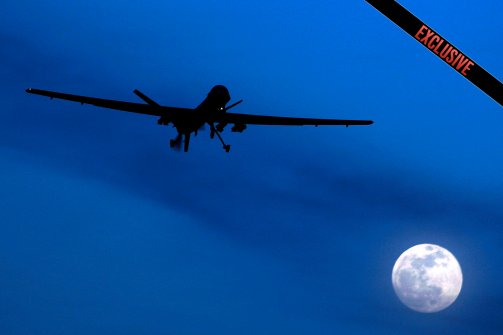
Exclusive: No More Drones for CIA
Daniel Klaidman
At a time when controversy over the Obama administration’s drone program seems to be cresting, the CIA is close to taking a major step toward getting out of the targeted killing business. Three senior U.S. officials tell The Daily Beast that the White House is poised to sign off on a plan to shift the CIA’s lethal targeting program to the Defense Department.
In this January 31, 2010, file photo, an unmanned U.S. Predator drone flies over Kandahar Air Field, southern Afghanistan. (Kirsty Wigglesworth/AP)
The move could potentially toughen the criteria for drone strikes, strengthen the program’s accountability, and increase transparency. Currently, the government maintains parallel drone programs, one housed in the CIA and the other run by the Department of Defense. The proposed plan would unify the command and control structure of targeted killings and create a uniform set of rules and procedures. The CIA would maintain a role, but the military would have operational control over targeting. Lethal missions would take place under Title 10 of the U.S. Code, which governs military operations, rather than Title 50, which sets out the legal authorities for intelligence activities and covert operations. “This is a big deal,” says one senior administration official who has been briefed on the plan. “It would be a pretty strong statement.”
Officials anticipate a phased-in transition in which the CIA’s drone operations would be gradually shifted over to the military, a process that could take as little as a year. Others say it might take longer but would occur during President Obama’s second term. “You can’t just flip a switch, but it’s on a reasonably fast track,” says one U.S. official. During that time, CIA and DOD operators would begin to work more closely together to ensure a smooth hand-off. The CIA would remain involved in lethal targeting, at least on the intelligence side, but would not actually control the unmanned aerial vehicles. Officials told The Daily Beast that a potential downside of the agency’s relinquishing control of the program was the loss of a decade of expertise that the CIA has developed since it has been prosecuting its war in Pakistan and beyond. At least for a period of transition, CIA operators would likely work alongside their military counterparts to target suspected terrorists.
Back in July 2012, Daniel Klaidman shed some light on Obama's drone program in this op-vid.
The policy shift is part of a larger White House initiative known internally as “institutionalization,” an effort to set clear standards and procedures for lethal operations. More than a year in the works, the interagency process has been driven and led by John Brennan, who until he became CIA director earlier this month was Obama’s chief counterterrorism adviser. Brennan, who has presided over the administration’s drone program from almost day one of Obama’s presidency, has grown uncomfortable with the ad hoc and sometimes shifting rules that have governed it. Moreover, Brennan has publicly stated that he would like to see the CIA move away from the kinds of paramilitary operations it began after the September 11 attacks, and return to its more traditional role of gathering and analyzing intelligence.
Lately, Obama has signaled his own desire to place the drone program on a firmer legal footing, as well as to make it more transparent. He obliquely alluded to the classified program during his State of the Union address in January. “In the months ahead,” he declared, “I will continue to work with Congress to ensure that not only our targeting, detention, and prosecution of terrorists remain consistent with our laws and systems of checks and balances, but that our efforts are even more transparent to the American people and to the world.”
Shortly after taking office, Obama dramatically ramped up the drone program, in part because the government’s targeting intelligence on the ground had vastly improved and because the precision technology was very much in line with the new commander in chief’s “light footprint” approach to dealing with terrorism. As the al Qaeda threat has metastasized, U.S. drone operations have spread to more remote, unconventional battlefields in places like Yemen and Somalia. With more strikes, there have been more alleged civilian casualties. Adding to the mounting pressure for the administration to provide a legal and ethical rationale for its targeting polices was the killing of Anwar al-Awlaki, a senior commander of al Qaeda’s Yemen affiliate, who also happened to be a U.S. citizen. (Two weeks later, his 16-year-old son was killed in a drone strike, which U.S. officials have called an accident.) The recent nomination of Brennan to head the CIA became a kind of proxy battle over targeted killings and the administration’s reluctance to be more forthcoming about the covert program. At issue were a series of secret Justice Department legal opinions on targeted killing that the administration had refused to make public or turn over to Congress.
http://www.thedailybeast.com/articles/2013/03/19/exclusive-no-more-drones-for-cia.html
